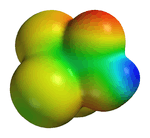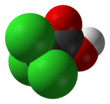Trichloroacetic acid
Trichloroacetic acid (TCA; TCAA; also known as trichloroethanoic acid) is an analogue of acetic acid in which the three hydrogen atoms of the methyl group have all been replaced by chlorine atoms. Salts and esters of trichloroacetic acid are called trichloroacetates.
| |||
 | |||
| Names | |||
|---|---|---|---|
| IUPAC name
Trichloroacetic acid | |||
| Identifiers | |||
CAS Number |
|||
3D model (JSmol) |
|||
| ChEMBL | |||
| ChemSpider | |||
| ECHA InfoCard | 100.000.844 | ||
| KEGG | |||
PubChem CID |
|||
| RTECS number |
| ||
| UNII | |||
CompTox Dashboard (EPA) |
|||
InChI
| |||
SMILES
| |||
| Properties | |||
Chemical formula |
C2HCl3O2 | ||
| Molar mass | 163.38 g·mol−1 | ||
| Appearance | Colorless to white, crystalline solid | ||
| Odor | sharp, pungent [1] | ||
| Density | 1.63 g/cm3 | ||
| Melting point | 57 to 58 °C (135 to 136 °F; 330 to 331 K)[2] | ||
| Boiling point | 196 to 197 °C (385 to 387 °F; 469 to 470 K)[2] | ||
Solubility in water |
Soluble in 0.1 parts[2] | ||
| Vapor pressure | 1 mmHg (51.1°C)[1] | ||
| Acidity (pKa) | 0.66[3] | ||
Magnetic susceptibility (χ) |
-73.0·10−6 cm3/mol | ||
| Structure | |||
Dipole moment |
3.23 D | ||
| Hazards | |||
EU classification (DSD) (outdated) |
Corrosive (C) Dangerous for the environment (N) | ||
| R-phrases (outdated) | R35, R50/53 | ||
| S-phrases (outdated) | (S1/2), S26, S36/37/39, S45, S60, S61 | ||
| NFPA 704 (fire diamond) | 
1
3
0 | ||
| Lethal dose or concentration (LD, LC): | |||
LD50 (median dose) |
5000 mg/kg orally in rats[2] | ||
| NIOSH (US health exposure limits): | |||
PEL (Permissible) |
none[1] | ||
REL (Recommended) |
TWA 1 ppm (7 mg/m3)[1] | ||
IDLH (Immediate danger) |
N.D.[1] | ||
| Related compounds | |||
Related chloroacetic acids |
Chloroacetic acid Dichloroacetic acid | ||
Related compounds |
Acetic acid Trifluoroacetic acid Tribromoacetic acid | ||
Except where otherwise noted, data are given for materials in their standard state (at 25 °C [77 °F], 100 kPa). | |||
| Infobox references | |||
Synthesis
It is prepared by the reaction of chlorine with acetic acid in the presence of a suitable catalyst.
- CH
3COOH + 3Cl
2 → CCl
3COOH +3HCl
Another route to trichloroacetic acid is the oxidation of trichloroacetaldehyde.
Use
It is widely used in biochemistry for the precipitation of macromolecules, such as proteins, DNA, and RNA. TCA and DCA are both used in cosmetic treatments (such as chemical peels and tattoo removal) and as topical medication for chemoablation of warts, including genital warts. It can kill normal cells as well. It is considered safe for use for this purpose during pregnancy.[4][5]
Its sodium salt was used as an herbicide starting in the 1950s but regulators removed it from the market in the late 1980s and early 1990s.[6][7][8][9]
History
The discovery of trichloroacetic acid by Jean-Baptiste Dumas in 1839 delivered a striking example to the slowly evolving theory of organic radicals and valences.[10] The theory was contrary to the beliefs of Jöns Jakob Berzelius, starting a long dispute between Dumas and Berzelius.[11]
See also
- Chloroacetic acids
References
- NIOSH Pocket Guide to Chemical Hazards #0626National Institute for Occupational Safety and Health (NIOSH)
- Budavari, Susan, ed. (1996), The Merck Index: An Encyclopedia of Chemicals, Drugs, and Biologicals (12th ed.), Merck, ISBN 0911910123
- Databog fysik kemi, F&K Forlaget 11. udgave 2009
- "Trichloroacetic Acid or Bichloroacetic Acid for Genital Warts (Human Papillomavirus)". WebMD.
- Wiley DJ, Douglas J, Beutner K, Cox T, Fife K, Moscicki AB, Fukumoto L (2002). "External genital warts: Diagnosis, treatment, and prevention". Clinical Infectious Diseases. 35 (Suppl 2): S210–S224. doi:10.1086/342109. PMID 12353208.
- TCA-sodium in the Pesticide Properties DataBase (PPDB), accessed June 20, 2014
- G. S. Rai and C. L. Hamner Persistence of Sodium Trichloroacetate in Different Soil Types Weeds 2(4) Oct. 1953: 271-279
- OECD Trichloroacetic Acid CAS N°: 76-03-9 Accessed June 20, 2014
- EPA December 1991. trichloroacetic acid (TCA) EPA Cancellation 12/91 Accessed June 20, 2014
- Dumas (1839). "Trichloroacetic acid". Annalen der Pharmacie. 32: 101–119. doi:10.1002/jlac.18390320109.
- William Albert Noyes (1927). "Valence". Proceedings of the American Philosophical Society. 66: 287–308. JSTOR 3301070.

